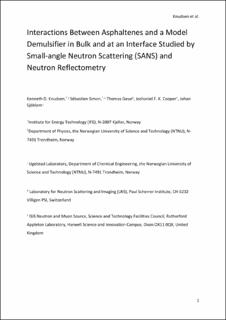Interactions between Asphaltenes and a Model Demulsifier in Bulk and at an Interface Studied by Small-Angle Neutron Scattering (SANS) and Neutron Reflectometry
Knudsen, Kenneth Dahl; Simon, Sebastien Charles; Geue, Thomas; Joshaniel F. K., Cooper; Sjøblom, Johan
Peer reviewed, Journal article
Submitted version

Permanent lenke
https://hdl.handle.net/11250/2660335Utgivelsesdato
2020Metadata
Vis full innførselSamlinger
Sammendrag
This article describes neutron reflectometry to probe the structure of the asphaltene layer adsorbed onto a hydrophilic silicon surface and the interactions between asphaltenes and a model demulsifier (pluronic). To start with, asphaltene nanoaggregation is studied in bulk by small-angle neutron scattering (SANS). In pure toluene, asphaltenes form nanoaggregates with sizes that are found to moderately increase when heptane is added. Then, the structure of the asphaltene layer onto a silicon surface is determined by neutron reflectometry. It is first shown that conclusive results on the structure of the adsorbed asphaltene layer can only be determined by varying the scattering length density of the solvent, i.e., by measuring reflectivity curves in various mixtures of D- and H-toluene and by simultaneously fitting all the data sets. The asphaltene layer can be successfully modeled using a single layer; a two-layer model always converges with the second layer having zero thickness. This layer has a thickness of 51 Å, with a low solvation close to the silicon surface (estimated ≈29%). The solvation increases with distance from the silicon oxide layer, reaching finally a value of 91%. Small-angle neutron scattering data indicate that the thickness is close to twice the radius of gyration of asphaltene nanoaggregates in solution. This result indicates that the extent of the asphaltene layer is linked to its self-associative properties in bulk. Finally, using the results obtained by contrast matching to constrain the fitting, the influence of a model demulsifier (pluronic PE 8100) on the asphaltene layer is investigated. In the presence of pluronic, the layer does not protrude as far into the bulk (thickness is reduced) and becomes rougher due to the partial incorporation of pluronic.